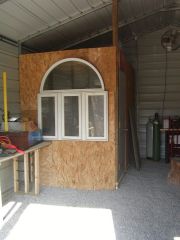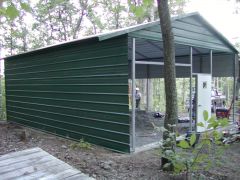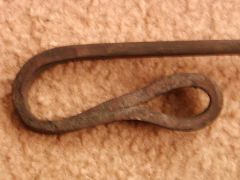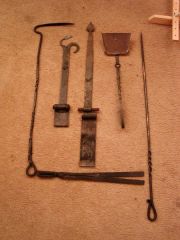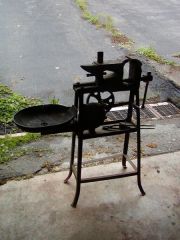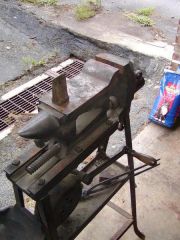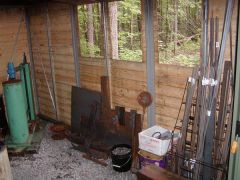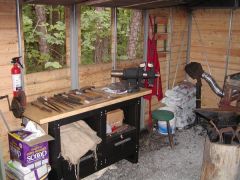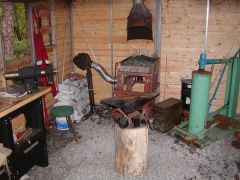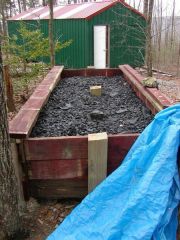
MooseRidge
Members-
Posts
159 -
Joined
-
Last visited
Content Type
Profiles
Forums
Articles
Gallery
Downloads
Events
Everything posted by MooseRidge
-
I tried it last night and downloaded the mods that was earlier in the thread... Looks like it should be easier than what I've been doing.... certainly do NOT want to do another scale mockup.....
-
From the album: Moose Ridge
The enclosed 6'x8' glass room is for working glass beads, fusing, and slumping. The workbench on the left has 20' of rack against the wall that passes thru and behind the wall. The windows were salvage from a previous project with the bottom ones opening for ventilation. You can just see the edge of the 3' diameter stump that is for my anvil and swedge block. -
From the album: Moose Ridge
The new forge building is complete. It is 20'x24', 8' walls, 11' peak. Metal construction with packed gravel floor. 7'x9' roll-up door & 1 standard door. Several items have been installed: 6'x8' Glass Room with workbench(for warm glass work - bead-making, fusing, etc) workbench with storage for long stock(continues into glass room under glass room bench) Stump - 3.5' diameter x 3' tall - imbedded in ground (anvil and swage block base) Wire Crate - for scrap stock Exhaust Fan Items on site but not installed/ positioned - workbench with vise, grinder, drll press, grinder table, side-draft forge, slag tub, & 3'x6' jig/welding/layout table. Items pending - Tire Hammer, Treadle hammer, hammer/tong rack, & Propane forge -
Insanity happens
-
I've downloaded it but not had time to try it out yet... Regarding its 3D capabilities versus flat renderings, many of the people I have done work for have big problems visualizing things from drawings, pictures work better for them. I can sketch and draft, but only copy something with enough accuracy to really show the detail. I'm hoping that this program will help in that department.... The way I look at computers is as just another tool.... very specialized and only useful in a limited number of applications, but anything that saves time and money is worth the trouble.... I look at it as another form of jig, useful for making repetitive items.....
-
I think they were more of an inspection item... The slot with the angle on one side was to check the gripper bar alignment (many got twisted) and that would be what the straight slot was for, to torgue the bar back to true..... The local chicken rancher in Windsor, ME was not set up with auto feeders, but I've seen similiar tools used for moving belts....
-
I took mine apart and sanded the blades and the interior casing as well. Because of a slight wobble in the bearings, I took a pair of tongs and twisted each fan blade about .25 inches. It gave the walls that much more clearance and now its almost whisper quiet (unless you REALLY start to crank, then the air blast is very loud!)
-
Going along with the chain tool idea.... Big Dutchman makes chain-driven feeders for poultry farms.....
-
Mine's gravel over plastic sheet......Gives good support, but doesn't hurt my back and knees the way concrete or brick does....
-
From the album: Moose Ridge
Also done at Dollywood years ago.... A skill that requires constant usage to maintain..... Handle on first shovel.... kept as a reminder to keep practicing.... -
From the album: Moose Ridge
Here are the tools and hinges I made during a class at Dollywood (a long time ago).... Still have (and use) them as examples of first work and to guage improvement -
From the album: Moose Ridge
Dragon Head - Made in a class with Steve Williamson. 1 inch steel stock. Flames are electric shear shavings intertwined and MIGed in a punched depression in the mouth. Will add final view when complete... -
From the album: Moose Ridge
This is what I use for demos and on-location repairs.... (also been used to pre-heat coal for live steam locomotives!) -
From the album: Moose Ridge
This is my portable all-in-one forge. Hand-crank blower, anvil, vise combo. Other than a crack in the pan (which was bridged and bolted on both sides to strengthen), it's in perfect working order.... -
From the album: Moose Ridge
Treadle Hammer (Sledge-O-Matic style), steel rack and scrap, ladle and lead. -
From the album: Moose Ridge
Layout table, hand-crank grinder and vise Moved to new forge building -
From the album: Moose Ridge
Hand crank blower, junkyard forge (old cultipacker end disc cut in half - perfectly round cast iron rivet-style firepot complete with reinforced hole in center!), VERY basic threadle hammer, 174# Euroanvil. Wooden walled shed - 10'x12' with gravel floor Was very damp, drafty, and cramped.....Those things on the walls as crickets! Used to help me forge - would actually walk on the forge while I worked..... Replacement built and being outfitted....MUCH better! -
From the album: Moose Ridge
Coal bin in front of my old forge building. 15'x6'x3.5' of free, collected coal. High BTU, some sulfur, medium ash, low clinker..... Replacement in progress.... Building in picture is not forge. It is a general shop and storage for live steam trains. Now has transfer table and rails going into the large doors.... -
Due to other commitments, John Wayne will not be able to host workshop until maybe October/November. Clay is hoping to have workshop at his new shop late summer. If interested, please contact Clay.....
-
Something I learned at a JCCFS class.... Make an all metal tool handle similar to one used for a hot cut for a treadle hammer. Thread some clean cotton strips through the eye until the eye is fully wrapped. Dip the cotton into the heated wax/linseed/turpentine mixture until a large egg covers the end of the tool. Let both cool then keep them covered to prevent dust contamination. (They had an old ammo can 3/4 full, kept the tool inside as well). This way, your finish material is in a usable/mobile form, enough for a number of applications as well as minimizing the flash fire problem with the liquid "fuel" in the can.... Important Safety reminder: ALWAYS reheat the mixture in another pot (i.e. double-boiler) with plenty of water.... NEVER apply direct heat (saw a guy try to melt a puddle in a can of this stuff with a O/A torch - lost his mustache, eyebrows, and most of his hair! Though beating him about the head and shoulders WAS fun, he was very lucky no permanent damage!)
-
Probably chained to that "gas" bulldozer....:D
-
I've always found that any coal makes ash and clinker, however, "good" coal makes less clinker than "bad".... The stuff I've been using for years is technically "bad" coal, some sulfur, tends to clinker if not run hot, medium ash... however, puts out some major BTUs... and it was free! Sadly, I'm down to less than a ton, so I'll be coal shopping soon... Wagonmaster, if you are using charcoal, there is no problem especially just starting out. You'll have to watch if and when you switch to another fuel (as any of us do when we get "new" coal, each load acts slightly different than the last!) or if switch to or add a propane forge. Heating times will change, etc. I'm over in Dunlap if you ever happen to be in this neck of the woods....
-
Actually, its 4 pieces of .25" plate.... problem is, the group cutting out the sheets are not doing exacting cuts, so I will need to clamp and grind to true up the edges. The plan is to drill holes to grid a jig/welding table (approx. 3'x6'x 1"thick). Problem is, I have no way to lift the finished product, so I'm building up the table with pieces I can lift. I pick up the sheets today. Am currently looking at .5" holes centered every 1.5", so LOTS of holes. I am also getting an additional 3'x6' sheet (cut into 2'x3' pieces) to use as a cover for welding and layout.....
